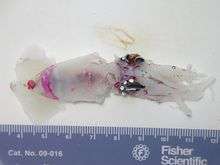Lampadioteuthis
| Lampadioteuthis | |
|---|---|
 | |
| Scientific classification | |
| Kingdom: | Animalia |
| Phylum: | Mollusca |
| Class: | Cephalopoda |
| Order: | Oegopsida |
| Family: | Lycoteuthidae |
| Subfamily: | Lampadioteuthinae Berry, 1916 |
| Genus: | Lampadioteuthis Berry, 1916 |
| Species: | L. megaleia[2] |
| Binomial name | |
| Lampadioteuthis megaleia[2] Berry, 1916 | |
Lampadioteuthis megaleia is a small, colorful squid from the family Lycoteuthidae, it is the only species in the only genus in the monotypic subfamily Lampadioteuthinae, it is sometimes known as the wonderful firefly squid. It differs from the other species of the Lycoteuthidae mainly by having a hectocotylus in the males and by the possession of a rostrum on the gladius.
Description
Lampadioteuthis megaleia is a small squid which grows to a mantle length of 40 mm.[3] In males the right ventral arm is hectocotylized with an enlarged protective membrane over the mid-arm. It has four ocular photophores, arranged as three in a ventral line and one positioned laterally. The tentacles have five photophores which are set on a stalk. There are circular anal photophores on either side of the rectum, single elongated branchial photophores lie at the base of each gill, there are no abdominal photophores and a single photophore is situated to the rear of the abdomen between the inner surface of mantle and the viscera. There are a lot of functional chromatophores which are covered by a violet pigmented external skin. The males have a penis.[4]
Distribution
Lampadioteuthis megaleia occurs in the subtropical North Atlantic Ocean in the Gulf Stream and the northern Sargasso Sea and in the southwestern Pacific Ocean.[3] Its type locality is the Kermadec Islands, in the South Pacific Ocean,[1] In the eastern North Atlantic it has been reported from between the Azores and Spain south to 25°N while in the western North Atlantic it has been recorded at 40°N.[1]
Habitat and biology
Lampadioteuthis megaleia is found in the upper mesopelagic to epipelagic zones.[3] Little is known about its life history but the violet pigmentation in the skin lying over its photophores is assumed to act as a colour filter which enables the bioluminescence to be a closer match to the colour of the sun or moonlight downwelling from the surface. The photophores of species of squid in the genus Lycoteuthis have a very similar type of detached filter. Small, less than 8mm in mantle length, subadults have been found which are very similar to adults, except that some of the body proportions differ, the size of the photophores and only having the large photophore at the base of each tentacle.[4] The paralarva are planktonic.[1]
References
- 1 2 3 4 Barratt, I. & Allcock, L. (2014). "Lampadioteuthis megaleia". The IUCN Red List of Threatened Species. 2014: e.T163219A985685. doi:10.2305/IUCN.UK.2014-1.RLTS.T163219A985685.en. Downloaded on 07 March 2018.
- 1 2 Julian Finn (2016). "Lampadioteuthis megaleia Berry, 1916". World Register of Marine Species. Flanders Marine Institute. Retrieved 7 March 2018.
- 1 2 3 P. Jereb; C.F.E. Roper, eds. (2010). Cephalopods of the World an Annotated and Illustrated Catalogue of Cephalopod Species Known to Date Volume 2 Myopsid and Oegopsid Squids (PDF). Food and Agriculture Organisation Rome. p. 246. ISBN 978-92-5-106720-8.
- 1 2 Young, Richard E. & Michael Vecchione (2016). "Lampadioteuthinae Berry 1916, Lampadioteuthis Berry 1916. Lampadioteuthis megaleia Berry, 1916. Version 16 November 2016". The Tree of Life Web Project.
